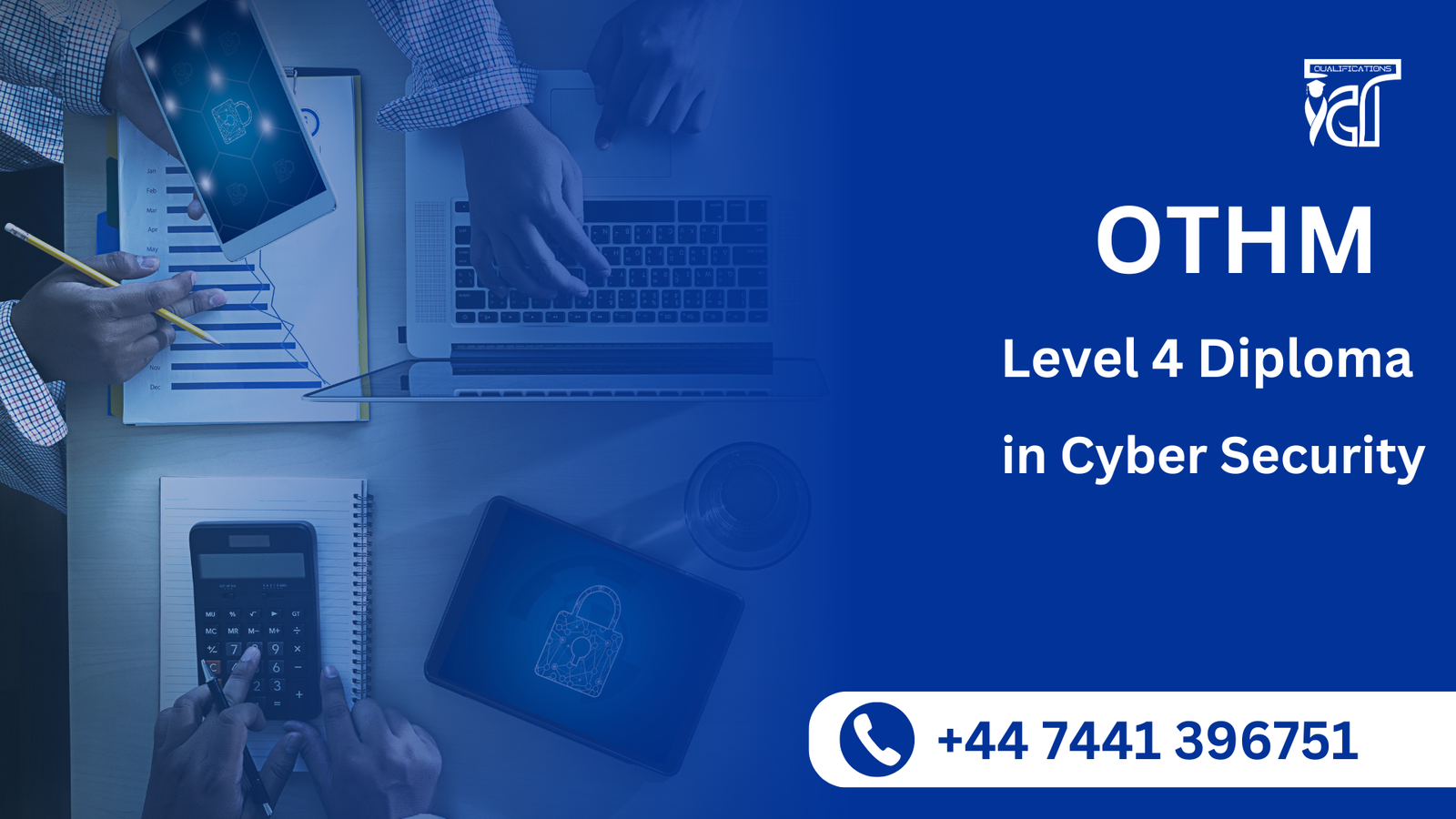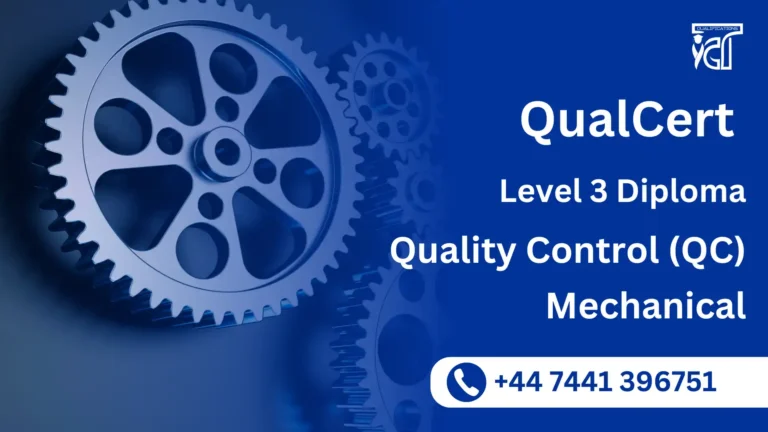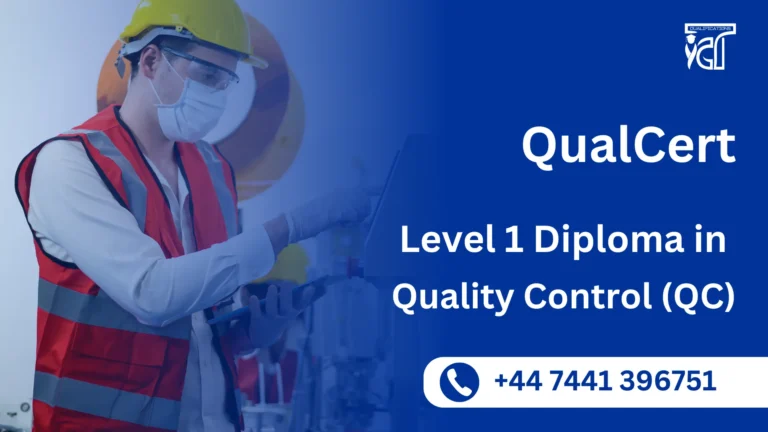In today’s digital world, cyber security has become a top priority for businesses, governments, and individuals. With the increasing risk of cyber threats, organizations are seeking skilled professionals who can safeguard sensitive data and systems. The OTHM Level 4 Diploma in Cyber Security, an Ofqual-regulated qualification, provides learners with a strong foundation in cyber security principles, preparing them for a rewarding career in this high-demand field.
This qualification is designed to equip students with the essential knowledge and skills required to understand and mitigate cyber threats. It is a completely assignment-based course, meaning there are no exams, allowing students to demonstrate their understanding through practical assessments.
The OTHM Level 4 Diploma in Cyber Security is an ideal choice for individuals looking to enter the cyber security sector with a well-structured and recognized qualification. Its assignment-based approach makes learning flexible and practical, preparing students for real-world challenges.
OTHM Level 4 Diploma in Cyber Security
The OTHM Level 4 Diploma in Cyber Security comprises six mandatory units, totaling 120 credits and 1,200 hours of Total Qualification Time (TQT). The recommended Guided Learning Hours (GLH) for this qualification is a minimum of 600 hours.
Level 4 Mandatory units:
| Sr# | Unit Title | Credits | GLH |
|---|---|---|---|
| 1 | Information Technology Security | 20 | 100 |
| 2 | Principles of Computer Science | 20 | 100 |
| 3 | Algorithms and Data Structures | 20 | 100 |
| 4 | Computer Networks | 20 | 100 |
| 5 | Mathematics for Computer Science | 20 | 100 |
| 6 | Operating Systems | 20 | 100 |
GLH (Guided Learning Hours) and TQT (Total Qualification Time) are terms commonly used in vocational qualifications to help define the amount of time a learner is expected to spend on heir studies.
1. GLH (Guided Learning Hours)
GLH refers to the number of hours a learner spends being directly taught, supervised, or supported during their course. This includes the time spent in activities such as:
- Classroom instruction
- Practical workshops
- One-on-one tutoring or mentoring sessions
- Online learning sessions with tutor support
In other words, GLH represents the time that learners are actively engaged with their instructors or learning activities.
2. TQT (Total Qualification Time)
TQT represents the total amount of time a learner is expected to invest in completing a qualification, including:
- GLH (Guided Learning Hours): Time spent on direct learning, as explained above.
- Self-Directed Learning: This includes time spent on independent study, research, assignment completion, preparation for exams, and any other work the learner does outside of direct teaching hours.
TQT is a broader measure that includes all the time required to achieve the qualification. It helps learners and employers understand the overall commitment required for the qualification.
Key Differences Between GLH and TQT:
- GLH focuses on direct learning with guidance or supervision.
- TQT includes GLH as well as independent study time and other learning-related activities.
Example:
If a qualification has a TQT of 600 hours and a GLH of 250 hours, it means the learner should spend 250 hours in direct learning (classroom, online, or tutor-led sessions) and 350 hours on independent study or research.
Learning Outcomes of OTHM Level 4 Diploma in Cyber Security
Information Technology Security
- Understand the nature of information and what is meant by information privacy.
- Understand key concepts in information security, including threats and risks.
- Understand the importance of secure design in Cyber Security systems.
- Be able to apply cryptographic techniques to encrypt and decrypt information.
- Understand legal and societal issues concerning information security.
Principles of Computer Systems
- Understand the architecture and key components of computer systems.
- Understand the types and functions of memory in computing systems.
- Be able to design and implement simple state machines
- Understand the fundamentals of logic circuits and gates.
- Understand the fundamentals of assembly language and how it relates to higher level programming languages.
Algorithms and Data Structures
- Understand a range of essential data structures.
- Understand algorithmic complexity and appreciate its importance.
- Understand a range of algorithmic techniques.
- Be able to write algorithms in popular programming languages
Computer Networks
- Understand the core principles of computer networks
- Understand how devices connect to form networks.
- Be able to design a computer network suited to a given setting.
Mathematics for Computer Science
- Understand binary and the representation of numbers in different bases.
- Understand the principles of propositional logic, set theory, and proof as applicable to computer science.
- Understand key topics in number theory and their application in computer science.
- Understand series and sequences and their importance in computer science.
- Understand key topics in linear algebra.
Operating System
- Understand the essential function and architecture of modern operating systems.
- Understand memory and I/O management techniques used by modern operating systems.
- Understand process management techniques used by modern operating systems.
- Understand the principles of and potential problems with concurrency in operating systems.
- Be able to write programs at the kernel level.
The Course Benefits of the OTHM Level 4 Diploma in Cyber Security are as :
Comprehensive Knowledge – Gain a strong foundation in key cybersecurity concepts, including risk management, network security, and ethical hacking.
Industry-Relevant Skills – Develop practical skills in cybersecurity that align with current industry standards and best practices.
Career Advancement – Enhance your job prospects in the rapidly growing cybersecurity sector with a globally recognized qualification.
Pathway to Higher Education – Progress to Level 5 and beyond, leading to advanced certifications or a full degree in cybersecurity.
Hands-on Learning – Engage in real-world case studies, simulations, and practical applications to strengthen your expertise.
Increased Earning Potential – Qualify for higher-paying roles in cybersecurity, such as security analyst, penetration tester, or IT security consultant.
Flexible Study Options – Suitable for both full-time and part-time learners, allowing you to balance study with work commitments.
Industry Demand – Meet the increasing demand for cybersecurity professionals across various industries, from finance to government and healthcare.
This course is designed for individuals who are passionate about cybersecurity and eager to build a career in this rapidly growing field. The ideal learner includes:
- Aspiring Cybersecurity Professionals – Those looking to enter the cybersecurity industry and gain foundational knowledge and skills.
- IT and Networking Professionals – Individuals with experience in IT, networking, or software development who want to specialize in cybersecurity.
- Recent Graduates – Students who have completed their secondary education or an IT-related qualification and wish to pursue a career in cybersecurity.
- Career Changers – Professionals from different fields looking to transition into the high-demand cybersecurity sector.
- Entrepreneurs & Business Owners – Individuals who want to protect their businesses from cyber threats and enhance their digital security knowledge.
- Government and Law Enforcement Personnel – Those working in security, law enforcement, or regulatory roles who need cybersecurity expertise.
- Lifelong Learners – Anyone with a keen interest in technology and security who wants to deepen their understanding of cyber threats and defense strategies.
Entry Requirements
Register Now
Qualification Process
Qualification Process OTHM Level 4 Diploma in Cyber Security
- Self-Assessment:
Begin by evaluating your eligibility to ensure you meet the qualification requirements, including work experience, knowledge, and language proficiency. - Registration:
Complete your registration by submitting the required documents, including a scanned copy of a valid ID, and paying the registration fee. - Induction:
An assessor will conduct an induction to confirm your eligibility for the course and explain the evidence requirements. If you do not meet the criteria, your registration will be canceled, and the fee will be refunded. - Assignments & Evidence Submission:
Provide all assignments and the necessary evidence based on the assessment criteria outlined in the course. If you are unsure of the required evidence, consult with the assessor for guidance on the type and nature of evidence needed. - Feedback and Revision:
The assessor will review your submitted evidence and provide feedback. Evidence that meets the criteria will be marked as “Criteria Met,” while any gaps will be identified. You will be asked to revise and resubmit if needed. - Competence Evidence:
Submit final evidence demonstrating that all learning outcomes have been met. This evidence will be marked as “Criteria Met” by the assessor once it is satisfactory. - Internal Quality Assurance (IQA):
The Internal Quality Assurance Verifier (IQA) will review your evidence to ensure consistency, quality, and compliance with standards. - External Verification:
The IQA will submit your portfolio to OTHM External Quality Assurance Versifier (EQA) for final confirmation. The EQA may contact you directly to verify the authenticity of your evidence. - Certification:
Upon successful completion of all checks, OTHM will issue your official certificate, confirming that you have attained the OTHM Level 4 Diploma in Cyber Security







